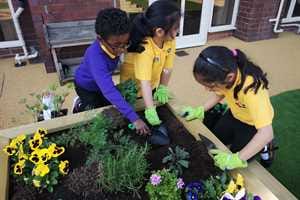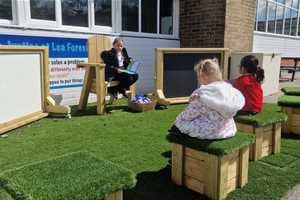
Outdoor Learning and Play
The Benefits of Risk-Taking during Outdoor Play
I must admit that when my children were toddlers I would run around after them, making sure they didn’t stumble and they didn’t hurt themselves, in a continuous effort to keep them ‘safe’. However, I do wonder can too much protection stop children from learning essential life skills and developing sensory awareness. Can children fully meet important physical development milestones and develop resilience if they don’t play independently outdoors and take some risks?
As a parent, perhaps I transfer my own fear to my children which can limit and restrict their play. In my efforts to keep my children contained and controlled they may not be reaching their full capabilities and learning which risks they can take.
Practitioners may also be fearful and anxious about adventurous play but if pupils are not given time to explore and play independently outdoors it can have a negative effect on communication and social skills, independence and imaginative thought. The word ‘risk’ can often be a concerning one for educators, yet we must consider the difference between putting a child at risk and allowing a child to take risks.
 This blog will explore outdoor play and risk-taking and how we can incorporate this into our settings to ensure a healthy child development.
This blog will explore outdoor play and risk-taking and how we can incorporate this into our settings to ensure a healthy child development.
Opportunities for Outdoor Play
Outdoor play allows children to be active and gives them freedom of movement to challenge their bodies throughout the day. Playing in the outside area allows children to feel free, perhaps from constant adult supervision. Pupils create their own secret, imaginary worlds, build hideouts, create their own trails and develop their own ideas.
Children are naturally curious and seek to make sense of the world. During outdoor play, children experiment with their surroundings, take risks and learn from their mistakes. When engaged in free play children, investigate, problem-solve, try things out and learn to negotiate.
When children are given time for free play, we help to prepare them for life as they learn essential physical and social skills.
Fear of Accidents
I have lost count of the number of times I have told my own children to ‘Be careful.’ My own natural instinct is to protect my child at all costs and my mind often imagines a worst-case scenario. However, as my oldest child has grown and developed, I have noticed that she is able to navigate her own risks and doesn’t put herself in situations where she is not entirely comfortable. I would often gasp at the slight sign of a bruise on my child’s legs after school but actually a bruise or a scrape can be a sign of a positive learning experience that is a natural part of a child’s physical development. When children experience a fall, they learn necessary skills such as using their hands for protection. These types of real-life experiences need to happen on occasion for pupils to develop effective motor skills, balance and resilience. How would we ever learn to ride a bike if we didn’t experience setbacks, loss of balance and minor injuries?
 In fact, if children are not exposed to freedom of movement outdoors, they don’t learn how to make adaptations and may be more likely to fall and seriously hurt themselves.
In fact, if children are not exposed to freedom of movement outdoors, they don’t learn how to make adaptations and may be more likely to fall and seriously hurt themselves.
Setting High Expectations
It is important to support children to assess and manage their own risk. Pupils will become confident in problem-solving and decision-making. Even young children can consider how to keep themselves and others safe, they can identify problems and think about what may need to be changed. Pupils don’t generally want to injure themselves or others and pick up on facial expressions, language and movements when others may feel unsafe.
If an adult always steps in during risky play, children can begin to doubt their own decisions. I have found it best to let a pupil know you are there if help is needed, ask how they feel and discuss possible changes to the challenge if necessary. It may be useful to ask another child to first demonstrate a task and reassure a child that if they change their mind, that is absolutely fine.
Children are often very good at selecting how much, how fast and how high. One child’s risky play may appear very different from another’s. For one child stepping across a log bridge will be thrilling whereas another may complete full turns on the rollover bars. If we are always restricting children from new experiences, they may not develop the necessary gross motor skills and could actually end up hurting themselves. If we give children plenty of opportunities to move their bodies from a young age, we are actually allowing them to become safer as they get older.
Observing Play
Standing back and watching pupils playing outside helps us to judge the level of support they need. In this way we don’t restrict children’s play or force them to take more risk than they want to. When we watch children, we learn what they can do and how they want to challenge themselves.
Most children are natural risk takers, they seek out play that gives them that funny feeling in their tummy! Children may force themselves to do things they’re afraid of in order to confront their fears and overcome them. For example, a child may leap from the top of the climber or crawl down a beam on their belly. If children are not given opportunities to expose themselves to new risks, fear can turn into phobia as they grow.
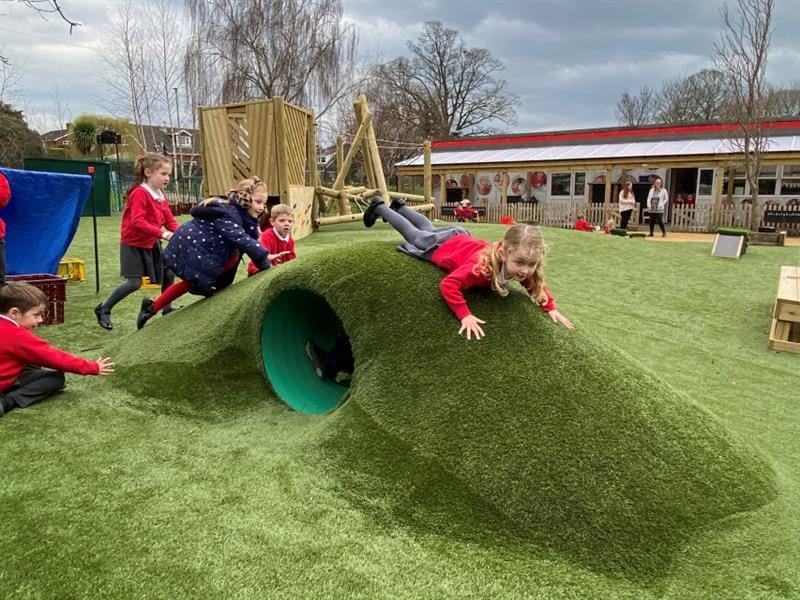 I will never forget taking year 6 children on residential trips and seeing them push their own capabilities. One particular child, who you would never imagine to be fearful, froze at the top of the climbing wall before abseiling down. With clam reassurance and encouragement, he was able to complete the task and you could see the sheer joy on his face at being able to complete something he felt was impossible. Gently exposing children to things they may be fearful of such as heights can actually help to alleviate the fear.
I will never forget taking year 6 children on residential trips and seeing them push their own capabilities. One particular child, who you would never imagine to be fearful, froze at the top of the climbing wall before abseiling down. With clam reassurance and encouragement, he was able to complete the task and you could see the sheer joy on his face at being able to complete something he felt was impossible. Gently exposing children to things they may be fearful of such as heights can actually help to alleviate the fear.
Developing Perseverance
During outdoor play children will try again and again until they achieve something. When pupils try, fail, adjust and try again they develop physical and emotional resilience. We can help to develop children’s resilience by not always helping or offering a solution straight away. Sometimes children need more time to achieve their goal and the sense of satisfaction will be grater if they do so without adult support.
It is useful to use positive language with pupils and to praise the process not the outcome. Sometimes asking open questions such as, ‘Where do you think your foot should go next? Do you feel safe? If you place your hand here, does it feel less wobbly?’ can help children to think about their decisions and next steps.
Children with Disabilities
Children with disabilities in particular may benefit from outdoor, risky play experiences. Motor and sensory limitations may limit movement and exploration of the environment and intellectual limitations may make it more difficult for the child to assess and deal with risks.
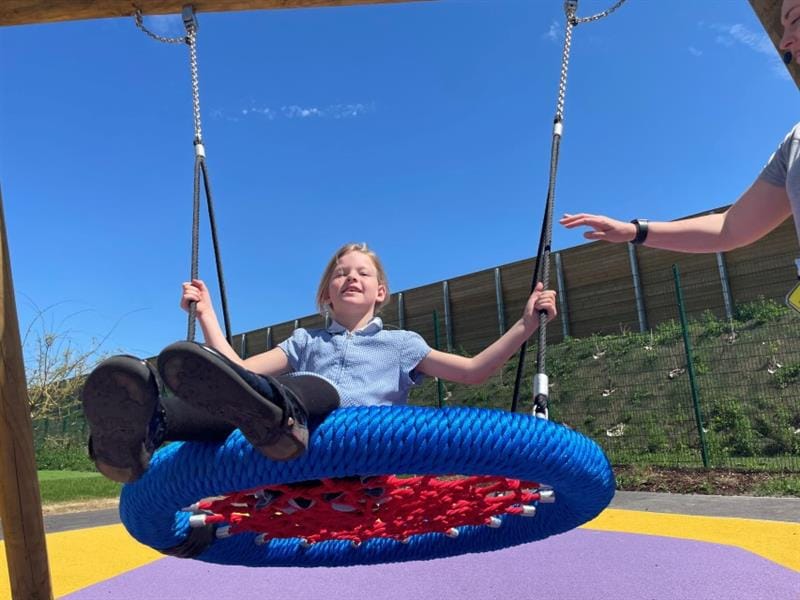
Pentagon’s Inclusive Roundabout and Wheelchair Swing ensure suitable accessibility for disabled learners. Large loose parts such as a Play Builder Set, Play Blocks and Water Wall allow children with disabilities to experience active and creative ways of playing. A child in a wheelchair is able to move water channels and slot them into the brackets on the peg board. Uneven surfaces created by playground mounds, wood chipping or sand provide different levels of challenge for disabled children/ wheelchair users to explore.
Ellen Sandseter’s 6 Categories of Risky Play
Dr Ellen Sandseter identified and categorised 6 areas of risky play through observation of children at Norwegian preschools. I will explore some of these categories in greater detail.
• Great heights
• Rapid Speeds
• Dangerous Tools
• Dangerous Elements
• Rough and Tumble
• Disappearing or Getting Lost
Great Heights
Children seek opportunities to climb to great heights and will often jump, balance, hang or swing from those heights. When practising climbing children may become frustrated but over time can build determination and will feel a sense of pride and achievement when they reach their goal.
At first, children will usually climb on low heights such as a Pinnacle Hill Climber which helps to build confidence. Climbing helps children to improve their balance and gain body awareness. Pupils learn to think about their footwork and carefully consider foot placement.
Product Spotlight
Climbing often leads to jumping and through free play pupils learn to assess heights and learn to land safely.
Rapid Speeds
Children often move at great speed, looking for opportunities to run, swing, slide, roll, spin and ride. Bikes and trikes often zoom round the racetrack, hills are used to slide down and jumping from swings whilst in motion can be a thrilling activity.
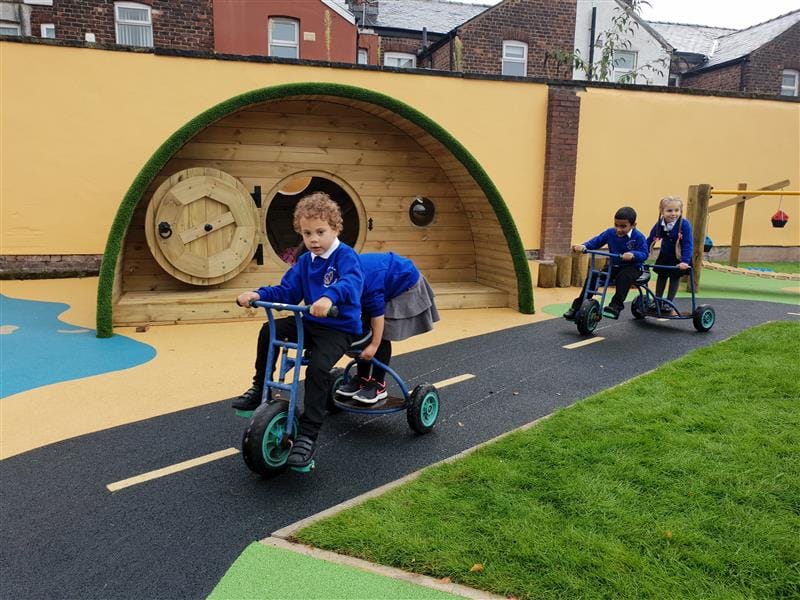
Pupils often test their comfort levels when playing at high speeds. If they experiment, children will know how to adjust their speed to their activity and ability.
Disappearing or Getting Lost
Pupils like to play and explore unfamiliar spaces either alone or in small groups. The use of landscaping, playground mounds and Hobbit Playhouses can provide structured hiding spots for children, that allow them to feel as though they are hidden away from adult supervision. This type of play allows children to feel a thrilling sense of independence. Children can test their own limits, which leads to increased self- awareness.
With the constant spread of new technology, it is vital that children are able to engage and interact through outdoor play. Most children have an appetite for risk taking and through this type of play we help to build children’s character and personality. Children want to play outside. They want bigger and better outdoor play environments with more exciting, varied and challenging equipment and activities available to them.
Over the last 30 years, children’s lives have become much more restricted and controlled. Opportunities for children to play and explore their own neighbourhoods have decreased, with children spending more time under adult supervision at home. An outdoor provision in schools today plays such an important role in offering children a place where they can enjoy challenging, self-directed activities. If play provision is not challenging enough for pupils will children seek out risks elsewhere, in environments that are not controlled or designed for them?
At times, as a parent, I may be fearful of risky play but I realise it is an essential part of growing up and child development. Taking risks helps children to develop physical skills and an awareness of senses which leads to safer, more resilient children.
Children need opportunities to take risks, overcome their own fears and anxieties and build their character. When children fail and make mistakes, they will ultimately become more confident when facing future challenges.
.jpg)

.jpg)
.jpg)


